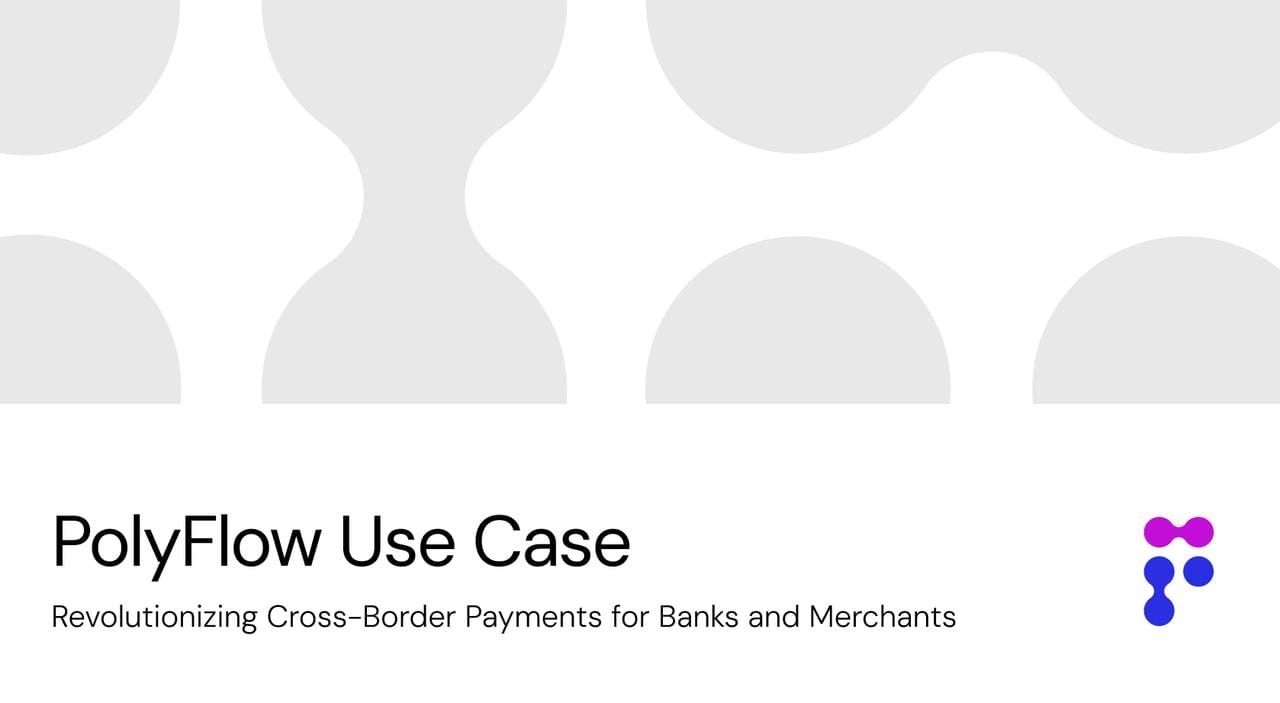PolyFlow Use Case: Revolutionizing Cross-Border Payments for Banks and Merchants
Imagine a Brazilian bank with a roster of merchant clients who need to pay their Chinese suppliers regularly. These payments, critical to maintaining global supply chains, currently navigate a labyrinth of traditional banking rails or costly crypto-based solutions. The result? High fees, delayed settlements, and a lack of control over funds in transit.PolyFlow’s revolutionary cross-border payments solution, powered by our PolyFlow Liquidity Pool (PLP), changes the game. By leveraging blockchain

Imagine a Brazilian bank with a roster of merchant clients who need to pay their Chinese suppliers regularly. These payments, critical to maintaining global supply chains, currently navigate a labyrinth of traditional banking rails or costly crypto-based solutions. The result? High fees, delayed settlements, and a lack of control over funds in transit.PolyFlow’s revolutionary cross-border payments solution, powered by our PolyFlow Liquidity Pool (PLP), changes the game. By leveraging blockchain technology, self-custody protocols, and optimized settlement systems, PolyFlow eliminates the inefficiencies of traditional systems while dramatically reducing costs compared to existing crypto rails. Here’s how we do it.
The Pain Points of Traditional Cross-Border Payments
For decades, global commerce has relied on traditional banking systems like SWIFT for cross-border payments. While reliable, these systems come with significant drawbacks:
- Multiple Intermediaries: Payments often pass through a chain of correspondent banks, each taking a fee and adding potential delays.
- High Costs: Banks charge steep transaction fees, foreign exchange markups, and additional charges for regulatory compliance.
- Slow Settlements: Payments can take days, sometimes weeks, to clear—especially when intermediaries are in different time zones or dealing with compliance checks.
- Lack of Transparency: Businesses rarely have real-time visibility into where their funds are in the settlement process.
Even crypto-based solutions, heralded as the future of payments, often fall short. Many platforms rely on centralized third-party processors like Fireblocks or Blockdaemon to manage wallets and liquidity. These processors buy costly block addresses for each transaction, driving up costs and eroding the efficiencies blockchain technology promises.
How PolyFlow Liquidity Pool (PLP) Solves the Problem
PolyFlow is designed to sidestep the pain points of both traditional banking and centralized crypto processors. At the core of our solution is the PolyFlow Liquidity Pool (PLP), which delivers unmatched efficiency, transparency, and cost savings. Here’s how it works:
- Self-Custody and Smart Contracts
Unlike third-party custodial solutions, PolyFlow ensures funds remain in the client’s wallet throughout the transaction process. Our system leverages self-executing smart contracts, which act as programmable agreements between the sender and recipient. Money never leaves the customer’s control until the transaction is completed, minimizing counterparty risk and ensuring total transparency. - No Third-Party Processors
By eliminating reliance on intermediaries like Fireblocks, PLP avoids costly processing fees associated with address purchases. Transactions are conducted directly, leveraging the liquidity pool to provide seamless value transfer. - Efficient Settlement
Once a transaction is initiated, our system accesses liquidity in real-time to execute the payment. When off-ramped, funds are processed through our fully licensed banking partners across key regions like the US, EU, UK, and APAC, ensuring compliance and quick settlement. - Cost Savings
PLP reduces fees to a fraction of what traditional banking or centralized crypto processors charge. Without intermediaries taking their cut, businesses keep more of their money while enjoying faster settlement times.

A Real-World Example: Brazilian Merchants Paying Chinese Suppliers
Let’s revisit our Brazilian bank example. Today, a merchant in Brazil looking to pay their supplier in China might face:
- Fees of up to 6-8% on the transaction, including foreign exchange markups and intermediary bank charges.
- Delays of 3-5 business days or longer due to time zone differences and regulatory checks.
- Lack of control over funds during transit, leaving them at the mercy of correspondent banks.
With PolyFlow:
- Fees drop to below 2%, thanks to our direct wallet-to-wallet transactions and streamlined liquidity model.
- Settlements occur in near real-time, often within minutes, bypassing the multi-day delays of traditional systems.
- Full control is maintained through self-custody, ensuring funds only leave the merchant’s wallet when the payment is ready to settle with the Chinese supplier.
Why Self-Custody Matters
One of PolyFlow’s standout features is its self-custody model, powered by smart contracts. In traditional systems, funds are often held in custodial accounts, introducing risks such as:
- Counterparty Delays: Funds can be held up if the intermediary faces technical or compliance issues.
- Transparency Gaps: Clients have limited insight into the transaction’s progress.
- Security Risks: Custodial wallets are attractive targets for cyberattacks.
With PolyFlow, businesses remain in control. Our self-custody model eliminates counterparty risk, ensures funds are secure until the moment of settlement, and provides complete transparency throughout the transaction.
A Licensed, Global Solution
PolyFlow isn’t just fast and cost-effective—it’s also compliant. Our banking rails are fully licensed in the US, Canada, UK, EU, Africa, China and APAC regions, providing businesses with the assurance that their payments are processed within a robust regulatory framework. This ensures smooth cross-border transactions without the regulatory headaches that can plague unlicensed systems.
The Future of Cross-Border Payments
PolyFlow represents the next evolution in cross-border payments. By cutting out intermediaries, leveraging blockchain for transparency, and putting control back into the hands of clients through self-custody, we’re creating a payments infrastructure that’s faster, cheaper, and more reliable.For banks, fintechs, and businesses looking to optimize their global payment workflows, PolyFlow is the partner you’ve been waiting for. Say goodbye to the inefficiencies of traditional banking and centralized crypto rails, and embrace a smarter way to move money worldwide.
Ready to transform your cross-border payments? Contact us today to learn more about PolyFlow.
SOCIALS
To find out more about PolyFlow and keep up with our latest developments, follow the official channels.
📣Mirror | 💬 Global Community | 👾 Discord| 🐦 Twitter/X | 🌐 Website
CONTACT US
support@polyflow.tech